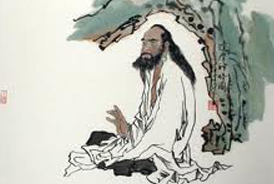The word Buddha is a Sanskrit word which means “The Awakened One”, one who’s awakened to Reality, who understands true nature of the mind, the world, and all animate existences.
 The Buddha lived around 3000 years ago . He was an Indian Prince named Siddhartha, who abandoned his throne in order to seek for the Truth, to discover a way to bring relief to the sufferings of human beings. After a lot of years of persevering practice, Hew’s achieved Supreme Enlightenment while sitting under a bodhi tree. He was called Sakyamuni (or Gautama) Buddha, and started an endless, compassionate travel to learn living beings how to see Reality, how to acquire true wisdom, how to free themselves, and how to attain true peace of mind and joy.
The Buddha lived around 3000 years ago . He was an Indian Prince named Siddhartha, who abandoned his throne in order to seek for the Truth, to discover a way to bring relief to the sufferings of human beings. After a lot of years of persevering practice, Hew’s achieved Supreme Enlightenment while sitting under a bodhi tree. He was called Sakyamuni (or Gautama) Buddha, and started an endless, compassionate travel to learn living beings how to see Reality, how to acquire true wisdom, how to free themselves, and how to attain true peace of mind and joy.
His learning is known as the Dharma. Bodhidharma (c. early 5th century) was the Buddhist monk traditionally credited as the transmitter of Zen to China.Most histories agree that he was South Indian Tamilian and was a Pallava prince from the kingdom of Kanchipuram, the third son of King Sugandha. Bodhidharma left the kindgom after becoming a Buddhist monk and travelled to Southern China and later resettled in the north. The accounts differ on the date of his arrival, with one early account claiming that he arrived during the Li Sng Dynasty (420479) and later accounts dating his arrival to the Ling Dynasty (502557).
Bodhidharma was principally active in the lands of the Northern Wi Dynasty (386534). Modern scholarship dates him to about the early 5th century.Tibetan sources give his name as “Bodhidharmottara” , that is, “Highest precept (dharma) of enlightenment”.Bodhidharma (Jp. Daruma) is frequently referred to as the founder of martial arts in both China and Japan. At the legendary Shaolin Temple in China, where Daruma is supposed to have achieved enlightenment, the temple even now conserves a large rock on which one can see Daruma’s shadow ,apparently burned into the rock during Daruma’s long years of meditation in front of it. Doshin So, who founded Japan’s Shorinji Kempo school in 1947, says Daruma appeared to him in a dream, and this inspired Doshin to establish his school.
Legends like this accept developed for the most part external Buddhism, with a stronger connexion to Daoist (Taoist) traditions. However, Bodhidharma’s title as founder of martial arts is still contested among scholars and historians.Soon after his death, someone supposedly saw Bodhidharma walking back toward India barefoot and with a single shoe in hand. His grave was later exhumed, and according to legend, the only thing found in it was the shoe he left behind. Bodhidharma is considered the founding patriarch of Chan, the Chinese precursor to Japanese Zen Buddhism.
Later Zen biographers of Bodhidharma arrogate that he was the twenty-eighth patriarch in a line of teachers traced directly to Shakyamuni Buddha. There are a lot of chronicles of his life, and altering legends connected with each, most of which historians haven’t been able to validate. The most popular legend is probably the one tying him to the famous Shaolin Temple in China, and by association, to Chinese kung fu.He instituted a series of physical exercises based on his Indian yoga and martial arts training to prepare the monk’s minds and bodies for meditation.
Historians consider that because a lot of military leaders retired to the Shaolin Temple, over time their physical training was also incorporated into these exercises to form the basis for Shaolin wushu, popularly known as kung fu. All of the subsequent wushu traditions accentuated the importance of total mind, body and spirit integration. Much later, when Chan Buddhism migrated to Japan, the Samurai class there also latched on to these teachings, incorporating them into their own martial-arts oriented branch of Zen.
Bodhidharma is referring to Shakyamuni’s first teaching, which is the Four Noble Truths. Namely, all existence is marked by suffering; suffering has a cause; the cause can be bought to an end; the way to bring it to an end is the Eightfold Noble Path of right views, right thought, right speech, right action, right livelihood, right effort/devotion, right mindfulness, right Zen.The practise of charity or generosity, morality or discipline, patience, energy or devotion, concentration or meditation, and wisdom are done without any concept of ‘myself’ doing them. Without any sense of ‘myself’ practising the Paramitas Bodhidharma can say they practise nothing at all. This is what’s meant by practising the Dharma.








































